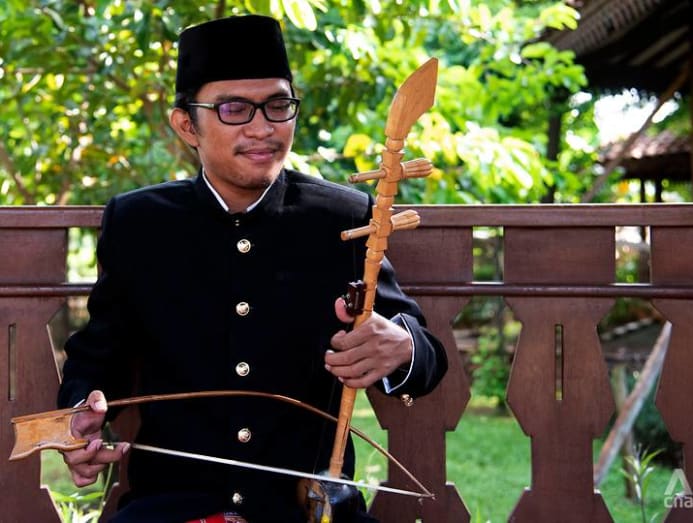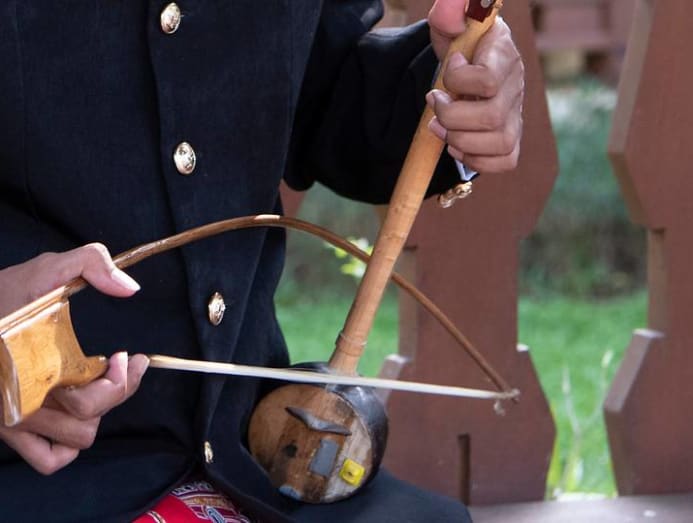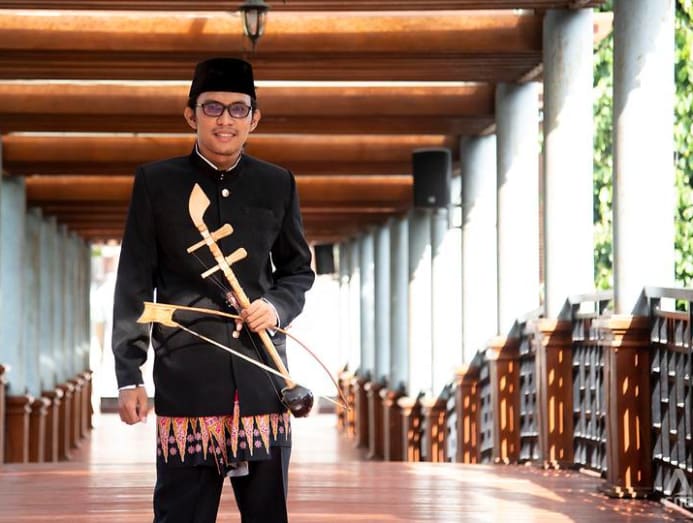From jazz to Mozart, young Indonesian breathes new life into centuries-old stringed instrument
JAKARTA: With groovy precision and agility, Seto Noviantoro's fingers glided beyond the strings of an Indonesian musical instrument, while his right arm moved the bow back and forth.
Despite its distinctive sound, not many people know the name of this two-string bowed fiddle, even in Dki jakarta where the musical instrument originated centuries ago. Those who know how to play the musical instrument are even rarer.
Noviantoro, 23, has been showcasing his kongahyan skills for the past five years on Instagram and YouTube, creating his ain renditions of anything from contemporary popular songs to jazz improvisations and Mozart'southward Turkish March.
The musician has also been updating traditional Betawi songs, rearranging them with modern beats and using both the kongahyan and contemporary instruments similar keyboards and electric bass to perform them.
"People think of traditional instruments as something old fashioned and irrelevant with today's time. I want to use social media to reintroduce kongahyan to the masses, and so people are aware that the Betawi (customs) has an instrument called kongahyan," Noviantoro told CNA.
"I get people interested by playing hit songs of today. People are intrigued and realise that this instrument is suited for all kinds of genres. Eventually, they will desire to know more than almost the instrument, what information technology is and where it'south from."
His endeavour soon attracted accomplished musicians, artists and producers like jazz veterans Tohpati Ario Hutomo and budding composer Eka Gustiwana, who invited him for collaborations, both on phase and on records.
A NATURAL TALENT
Although his father was a traditional Javanese gamelan (ensemble music) player, Noviantoro said he never expressed any real interest in becoming a musician as a male child.
"The only reason I enrolled for a traditional music major at my vocational school was considering my grades were not proficient plenty for regular high schools and other majors at the schoolhouse," he said.
Tourism Vocational School Number 57 in S Dki jakarta had simply opened a new major in traditional music by the fourth dimension Noviantoro graduated from junior high school in 2012. There was non much interest in the new programme and the then 14-year-old was accepted easily.
"My grade was the commencement batch. The programme was so new, nosotros didn't accept a teacher until the 4th day of school," he recalled.
READ: Heavy metallic loving graphic designer sets up wealth redistribution website to aid Indonesians hit by COVID-xix
The school eventually brought in Firman Jalut, a multi-instrumentalist and son of Betawi music maestro Babe Jali Jalut, to serve equally one of the plan's first teachers.
The first thing Firman did in Noviantoro'due south course was to bear witness a humble-looking wooden musical instrument well-nigh 60cm long, with a sound box made from dried coconut crush covered in caprine animal'south skin on one end and two tuning pegs at another. A curved bow is permanently wedged between the instrument's 2 strings.
Similar many others in Jakarta, Noviantoro had never seen such an instrument in person, permit lone played one. Most pupils in his class did non even know the instrument'southward name.
"My teacher stood in forepart of the class, rested the musical instrument confronting his waist and began to play. It produced the most beautiful and smoothest sound I have ever heard in my life. I was immediately hooked," he said.

Noviantoro proved to be a natural talent. His teacher Firman was so impressed by his educatee that one year later he began bringing Noviantoro along to perform equally a backup musician.
Firman even introduced Noviantoro to jazz veteran Dwiki Dharmawan, who at the time was looking to interact with a traditional musician for a major jazz festival subsequently that year.
READ: In traffic-choked Jakarta, volunteer motorcyclists assist ambulances weave through congestion
"During the rehearsal, I was told to improvise a kongahyan solo. I didn't know what to do. I had simply been learning kongahyan for a yr dorsum then," he said, adding that somewhen, Firman stepped in and took Noviantoro'southward place in the band.
Although he did not get to perform at the jazz festival, the feel made Noviantoro realise that the kongahyan is a versatile instrument which tin can fit into a wide diverseness of musical genres.
"I also realised that as a musician you have to be versatile in adapting to changes on the fly, be mindful of what other players are doing and be prepared to improvise," he said.
A twelvemonth after his come across with Dharmawan, he eventually got his 2nd risk to collaborate with the jazz veteran and perform in big concerts and festivals. Today, Noviantoro works as a full-fourth dimension musician.
KEEPING TRADITION Live
No 1 knows for sure when kongahyan was first invented – some historians believe it first emerged in the 15th century while others believe that it had been around for much longer.
However, anybody agrees that kongahyan, along with its bigger and lower-sounding siblings tehyan and sukong, were modelled after the Chinese erhu brought to the archipelago past merchants from mainland China.

The erhu was likewise the inspiration for some other instrument called rebab, which is plant in Sundanese and Javanese communities in other parts of Java.
While rebab is relatively well preserved, the same cannot be said most the Betawi stringed instruments.
"Perhaps it is because no one is teaching them. In West Java and Yogyakarta (provinces), they have schools and institutes dedicated to preserving their musical heritage and instruction the next generation of artists. For some reasons, nosotros don't have that here," Noviantoro opined.
"To exist honest, I am quite jealous of the other provinces."
READ: 'I'm equally adept as any human being' - Aceh activist champions megafauna sanctuary preservation
The musician believed that the traditional music of Djakarta is facing a chicken-and-egg state of affairs. "No 1 is teaching people these instruments considering no one is interested. No one is interested because no one is teaching them about it," he said.
Noviantoro aimed to change that through social media.
"I want to employ social media to reintroduce kongahyan to the masses so people are aware of the kongahyan instrument and that the Betawi (community) has instruments chosen kongahyan, tehyan and sukong," he said.
Noviantoro said he noticed many people his age are starting to prove an interest in the instrument. "I don't desire to say that it happens solely because of what I am doing on social media. Other musicians are also working hard to promote kongahyan in their own means," he said.
"I hope more and more than people are picking up kongahyan for the first fourth dimension. Goose egg would give me more than joy."

"I want the Betawi culture and music to be more well known, non but in Indonesia but also internationally. I believe that the Betawi civilisation can get the worldwide recognition that information technology deserves. But before we can do that, we take to start with ourselves kickoff. Nosotros must be the ones who appreciate information technology and preserve it."
Source: https://cnalifestyle.channelnewsasia.com/asia/indonesia-jakarta-betawi-seto-noviantoro-kongahyan-erhu-music-249236
0 Response to "From jazz to Mozart, young Indonesian breathes new life into centuries-old stringed instrument"
Post a Comment